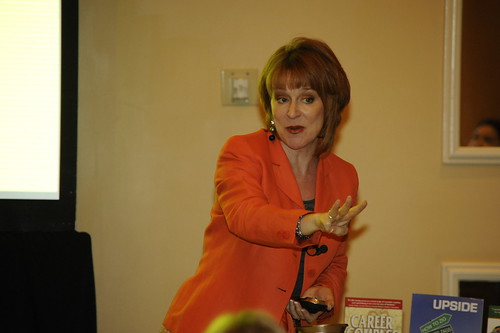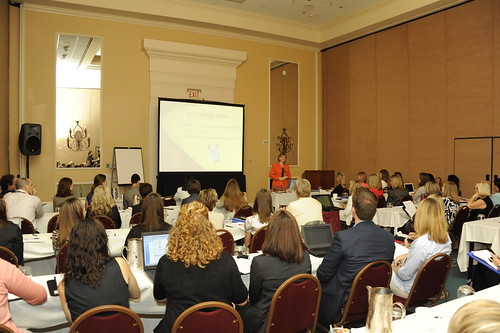

Allison Blankenship is a former practicing PR professional who is now a communications and business coach and trainer. She has lead thousands of people to perform under pressure and specializes in accelerating results. As one of the first 100 APRPs (predecessor to APR accreditation) in Florida, she is available to coach and train your team in persuasive presentations, developing executive presence, conflict resolution, how to be assertive without being pushy, how to talk so that other people listen, priority management and leveraging your strengths to build new business.
This was a great session for public relations pros looking to hone their communications skills to get buy-in and persuade for action.
This program taught attendees to:
- Think and speak clearly on their feet
- Use neutral words and defuse emotions
- Tap into natural motivators
- Gain compliance with one simple word
- Use buy-in to persuade
- Be seen as a polished communicator
“For persuasion to be truly effective, three elements must be present: trust, logic and emotion.”
– Aristotle
Allison addressed logic. Saying the problem with logic is the listener can get overwhelmed and overloaded by data.
This is addressed by adhering to the Rule of Three – proven science that indicates an adult must hear information a minimum of three times before they anchor it. Five would be the maximum memory for most adults, which is why they can remember their zip code but not their own zip code + 4.
Tip: have only three messages, or have only one message and repeat it three times
Allison talked about brain clutter. Estimates are that 94% of the time we think about ourselves. How can you cut through the brain clutter, present logic and convince and persuade?
She presented the concept of the IBC Strategic Script (intro, body conclusion):
- Tell them what you’re going to tell them
- Tell them
- Conclude
Allison had everyone stand up and practice the IBC form. Standing up uses a different set of neurological pathways and is more effective at training and anchoring the IBC technique.
Attendees practiced the IBC form talking about concepts like hot dogs, Brussels sprouts, themselves and why men are better than women (easy to a subject you may or may not believe in). Attendees practiced at 30, 45 and 60 second intervals in pairs.
After “mastering” the IBC form, she presented information about compliance with a single word – Adapted from Convince them in 90 Seconds by Nicholas Boothman.
The special word is: BEACAUSE. She said when we give people a reason to do what we want or need them to do, it encourages and automatic response based on reason. A Harvard University study found that using the word because increased compliance by 94 percent.
She then presented information about how to create buy-in with benefits. First, Allison taught attendees the difference between features and benefits. Features are measurable, aren’t very exciting, usually are “have to” actions, don’t create buy-in. Benefits are intangible, emotional, answer the question “What’s in it for me?”
With a simple example of buying a new car, features would be the car has good gas mileage, safety record, leather seats and GPS.
With the same example, benefits of the new car would be: saving money, feeling good, saving time, gaining peace of mind, comfort, sex appeal, convenience.
Allison then presented information on tapping into emotions professionally. First she suggested using neutral words. She presented the words: concern, frustration/frustrated (better word than mad, angry, upset), surprised/surprise (replace disappointment/disappointed with surprise). Try using these words that create less of an emotional response. Use these words in place of other emotional triggers when trying to diffuse situations.
There are seven subconscious motivators. Keep these in mind for all audiences.
People want:
- To be successful
- To be respected
- To be liked
- To be inspired
- To be valued and appreciated
- To belong
- To be safe
She then presented information on the “easy script” is a great tool. It’s a four step conversation model. This is a highly assertive tool, AND IS NOT FOR EMAIL. This is for in-person communications or phone conversations. EASY is for redirecting behavior or getting commitment.
E: Express how you feel (neutral words: frustrated, concern, surprise)
A: Address the facts – facts only, no judgment, no accusations
S: Spell out and specify the solution – the more specific you are the more likely you are to get a commitment.
Y: Get a Yes or a No.
There is an easy script article on Allison’s website.
In closing, Allison reminded attendees to address logic with no more than three concepts, use the IBC concept, use the word because when we want action and persuasion, know the difference between features and benefits as benefits are what sell, and to use neutral words all while understanding what motivates people.
It was great quick training that reminded attendees that there is science behind the art of public relations and communications.
